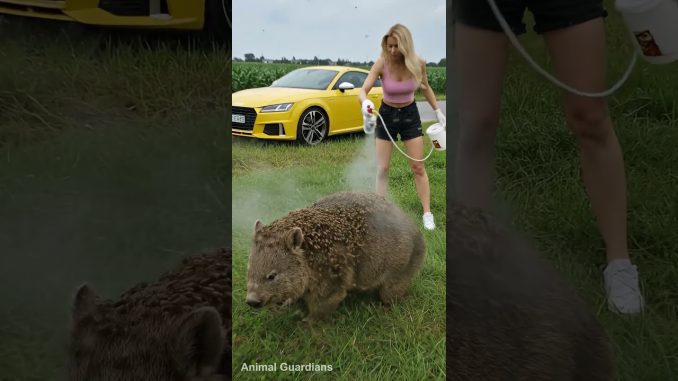
A short video titled “A Kind Girl Rescues the Helpless Wombat from a Swarm of Bees that Preyed on It” has recently drawn enormous attention online. Shared widely across social media, the clip—reported to come from a channel called Animal Guardians—shows a dramatic roadside “rescue” of a wombat covered in what appears to be a cluster of bees. While many viewers found the footage emotional, others raised questions about whether the video shows a genuine wildlife emergency or a digitally manipulated scene created primarily for entertainment.
The Scene That Captured Attention
The video opens with a wombat standing beside a rural road, appearing distressed as a dark, textured mass covers part of its back. The imagery suggests that the animal is dealing with a swarm of bees. The wombat shakes and rolls as if trying to remove the insects, setting a tone of urgency.
Moments later, a young woman arrives in a bright yellow sports car. Clearly alarmed, she approaches the animal and kneels beside it. Close-up shots emphasize a thick group of “bees” on the wombat’s fur. Despite the supposed danger, the animal remains unusually calm as the woman begins to stroke it.
The main “rescue” sequence features the woman using a spray bottle and a cloth to remove the swarm. The insects seem to disappear almost instantly as she wipes the fur, after which she hugs the wombat and gently places it back on the ground, apparently safe.
A Closer Look: Why Experts and Viewers Are Suspicious
Although the clip is framed as a heartwarming act of kindness, multiple details strongly hint that the scenario may be staged or digitally enhanced.
Unnatural Behavior and Unlikely Setting
Wombats are native to Australia and are rarely found near agricultural fields resembling those seen in the video. The landscape, vehicles, and farming equipment look more typical of North America or parts of Europe. This mismatch raises questions about where the footage was actually filmed and whether the animal was part of a controlled environment rather than a spontaneous rescue.
The “Bee Swarm” Looks Artificial
Real bees do not form thick, solid patches that stay perfectly in place on an animal’s fur. The cluster shown in the video appears unusually dense and uniform, resembling a texture overlay rather than a moving swarm. The visual “dispersal” of the insects when sprayed also looks digitally produced.
The Wombat’s Calm Reaction
A wild animal experiencing genuine discomfort—especially from insects—would likely be agitated, defensive, or attempting to flee. Instead, the wombat remains completely docile during spraying, rubbing, and handling, suggesting it was accustomed to humans or the distress was not real.
Lack of Safety Gear
Handling an active bee swarm without protective clothing would be extremely risky. The woman’s casual approach is inconsistent with a real scenario involving stinging insects.
Why This Matters
The video fits a growing pattern known as staged animal rescue content—clips that simulate dramatic scenarios to evoke strong emotional reactions. While many viewers enjoy uplifting stories, such staged scenes can mislead audiences about wildlife behavior and safe rescue practices.
What to Do in a Real Animal Emergency
If you ever encounter a wild animal in distress, the safest and most responsible action is to contact local wildlife professionals or emergency services. They have the training and equipment to assist without putting themselves or the animal at risk.